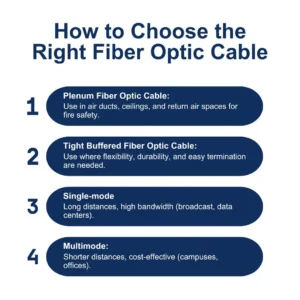
Designing High-Performance Networks with Fiber Optic Cables
Summary: Discover how system integrators are building scalable, future-ready networks using fiber optic cable solutions. This blog explores the practical considerations, industry-specific needs, and modern technologies like plenum fiber optic cable and tight buffered fiber optic cable. Ideal for professionals in broadcast, healthcare, corporate, and security sectors.
Did you know that fiber cables can transmit data at nearly the speed of light, with bandwidths of up to 100 Gbps and beyond? In an era where data demand is skyrocketing, fiber optics are no longer optional; they are foundational.
Whether it’s for broadcast studios transmitting 8K content, hospitals transferring diagnostic images, or smart campuses ensuring seamless connectivity, the choice of fiber optic is critical. This article offers a practical roadmap for system integrators to design robust, scalable networks using the right fiber technology
The Power of Fiber Optic Cable in Modern Network Design
Fiber optic cable is the backbone of next-generation network infrastructure. Unlike copper, it transmits data as pulses of light, allowing for:
- Blazing speeds: Up to 100 Gbps and beyond.
- Long-distance transmission: Minimal signal loss over kilometers.
- Immunity to electromagnetic interference: Ideal for electrically noisy environments.
- Superior security: Difficult to tap or intercept signals.
Fiber optic cabling is the lifeline of data center design and build, underpinning speed, scalability, and reliability in an era of AI, edge computing, and cloud dominance.
Designing for Scalability and Future-Proofing
Key Principles for System Integrators
- Understand bandwidth needs: Assess current and projected data loads for each environment, whether a broadcast studio streaming 8K video or a hospital with real-time medical imaging.
- Plan for growth: Design pathways and distribution points that can accommodate future cable runs and equipment upgrades.
- Redundancy: Build in backup fiber routes and failover hardware to ensure uninterrupted service, especially in mission-critical settings like healthcare and security.
- Flexible topologies: Use star, ring, or mesh designs as appropriate for the site’s size and reliability requirements.
Choosing the Right Fiber Optic Cable
| Application Area | Recommended Fiber Type |
Key Features |
|
Broadcast Studios |
Single-mode, Plenum |
Long runs, high bandwidth, and fire safety |
|
Corporate Campuses |
Multimode, Tight buffered |
Cost-effective, easy to install |
|
Healthcare Facilities |
Plenum fiber optic cable |
Low smoke, fire-resistant, safe for airspaces |
|
Security Systems |
Tight-buffered fiber optic cable |
Rugged, flexible, supports redundancy |
Plenum fiber optic cable is vital for installations in air-handling spaces, meeting strict fire codes and minimizing smoke in emergencies.
Tight buffered fiber optic cable is ideal for environments requiring flexibility, durability, and easier termination, such as security systems and complex campus layouts.

Fiber Optics Across Industries: Practical Use Cases & Benefits
Fiber Optic Cable plays a mission-critical role across multiple sectors, offering unmatched speed, reliability, and future-ready infrastructure.
Broadcast Studios
To handle uncompressed 4K/8K video and real-time production workflows, studios rely on fiber for:
- High-bandwidth video transport (e.g., SMPTE 2110 IP workflows; SMPTE 311M for camera cables)
- Ultra-low latency for live edits and effects
- EMI immunity in equipment-dense environments
- Durable tactical fiber for outside broadcast setups
“Studios are now being redesigned around fiber cores, not copper,” says veteran broadcast engineer Alex Chen.

Corporate Campuses
Fiber provides the digital backbone for modern enterprises through:
- Campus-wide connectivity with reduced signal loss
- Fiber-to-the-Desk (FTTD) or Fiber-to-the-Zone (FTTZ) using Riser or Plenum Fiber Optic Cable
- Reliable wireless backhaul for Wi-Fi 6/7 support
Healthcare Facilities
Fiber enables critical, interference-free data flow in medical environments:
- Rapid imaging transfer (MRI, CT scans)
- EMI immunity near sensitive devices
- Support for IoMT (Internet of Medical Things)
Security & Surveillance Systems
Next-gen security requires robust fiber backbones:
- Long-distance transmission for high-res IP cameras
- Signal integrity in EMI-heavy areas
- Scalability for AI video analytics and access systems

Want tailored advice? Request Information from Remee to get started on the right solution for your application.
Fiber optics are more than just a medium; they are a strategic advantage. Whether building a secure facility, a healthcare campus, or a broadcast-ready control room, designing with Fiber Optic Cable ensures your network infrastructure supports the bandwidth, speed, and safety of future technologies.
Need help planning your fiber infrastructure? Ask an expert to design a cable that performs today and evolves with your future needs.
FAQ: Fiber Optic Cable Network Design
Q1: Why choose fiber optic over copper for high-performance networks?
A: Fiber optics offer vastly higher bandwidth, longer transmission distances, and immunity to electromagnetic interference, making them ideal for environments with high data demands or electrical noise.
Q2: What is a plenum fiber optic cable, and when should it be used?
A: Plenum fiber optic cable is designed for use in air-handling spaces (plenums) and meets strict fire safety standards. It should be used wherever cables run through ceilings, ducts, or return air spaces.
Q3: How does tight buffered fiber optic cable differ from loose tube designs?
A: Tight buffered fiber optic cable is more flexible, easier to terminate, and better suited for indoor or campus environments where cables may need to be pulled through tight spaces or around corners.
Q4: How does designing with fiber optics “future-proof” a network?
A: Fiber optics future-proof networks primarily due to their immense bandwidth potential and long transmission distances.
- Bandwidth Headroom: The intrinsic capacity of fiber far exceeds current typical demands, meaning the physical cable itself can support multiple generations of network upgrades (e.g., from 10G to 40G, 100G, 400G, and beyond) simply by upgrading the active electronics (transceivers) at either end.
- Scalability: As discussed, fiber allows for high fiber counts and the use of WDM technologies, enabling easy expansion of capacity without needing to pull new cables.
- Emerging Technologies: As technologies like AI, virtual reality, augmented reality, and widespread IoT become mainstream and create new applications for cabling, they will require unprecedented bandwidth and low-latency capabilities that fiber networks are uniquely positioned to provide.
For more information about Remee’s Fiber Optic Cable offerings, please visit our web page on Fiber Optic Cables.